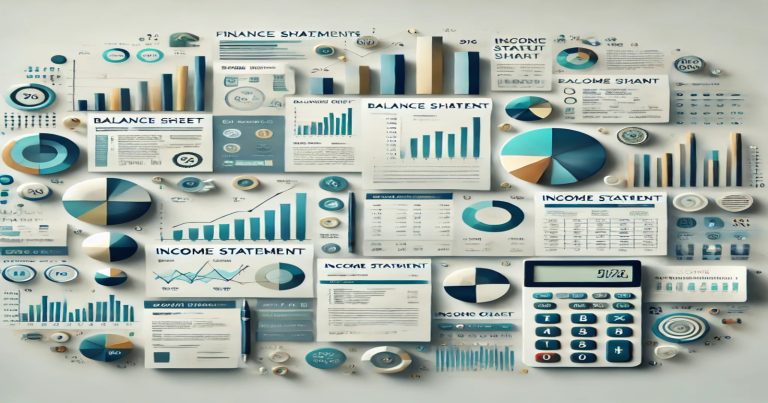Financial statements are written records that illustrate a company’s business activities and financial performance. They are usually audited to ensure tax, financing, or investing accuracy. Financial statements are legal documents that reflect the financial dealings and position of an enterprise, businessperson, or entity. These statements include a broad view of a company’s performance over time. A commercial firm uses financial statements to measure its financial health, profitability, and liquidity to assess the well-being of its financials, as seen by investors, creditors, management, and regulators. Other sources of financial statements generally include a balance sheet, a profit and loss statement, a cash flow statement, and a statement of changes in equity.
What are Financial Statements?
Financial statements are an organized means of summarizing the economic activities of a business for a period. Such an account shows how a company earns revenues, pays expenses, or creates and destroys owning and owing. It is used in every sphere, from attracting investors to getting loans to regulatory scrutiny. Thus, more emphasis is placed on the comprehension of financial statements and their role in making informed decisions on finance and operations.
Significant Components of Financial Statements
Each pocket of financial information complements the others into a well-rounded financial picture. The financial statements give the stakeholders different angles to assess economic performance and the organizational well-being. Failure to trace one component can lead to misinterpreting the overall economic situation of a company. Analyzing all components assists in making better investment, lending, and operational judgments.
Balance Sheet
The balance sheet shows what a company owns, owes, and its net worth at a particular date. It is divided into assets, liabilities, and equity, maintaining the accounting equation’s balance. Stakeholders assess financial stability, liquidity, and leverage through the balance sheet. A strong balance sheet builds investor and lender confidence in the business.
Income Statement
The income statement tracks how much revenue a company generates and what costs it incurs. It highlights operational efficiency and net profitability across different reporting periods. Comparing income statements year-over-year shows whether a business is growing, stagnant, or declining. It provides a basis for calculating important ratios like net profit margin and operating margin.
Cash Flow Statement
Cash flow statements record how effectively a company manages its cash inflows and outflows. Even profitable companies can fail if they have poor cash flow management. Understanding the sources and uses of cash helps predict whether the company can meet future obligations. Investors prefer companies with strong, predictable operational cash flows.
Statement of Changes in Equity
A compulsory summary under company law outlines the modifications in shareholders’ value with time through retained earnings, dividends, and new capital. It is necessary to monitor changes in equity to understand how management treats profits and expansion funding. It helps show how much profit is retained and reinvested versus distributed as returns to shareholders. Generally, a healthy increase in retained earnings is an essential indication of the company’s sustainable growth.
.
How Do Financial Statements Work?
Financial statements do not exist in isolation—they are generated under a systematic accounting framework. Every step in the accounting cycle underwrites that the final statement is valid, verifiable, and, most importantly, legally correct. If this rigorous procedure did not exist, the financial information might mislead stakeholders and tarnish the company’s reputation. Therefore, integrity in financial reporting helps in better decision-making, planning, and investor confidence.
- Recording Transactions
Integral to the fair working of accounts is the correct recording of financial transactions. Error in this stage can be amplified into significant mistakes thereafter, to the point where financial statements are drawn. Aids are available in accounting software programs for businesses to automate much of this data recording. Yearly recording is accurate, timely, and complete to avoid poor recognition of revenue or expenses.
- Prepare Trial Balance
A trial balance lists all accounts with debit and credit balances to find the out-of-balance amounts. Balanced books ensure adherence to the double-entry accounting principle. An imbalanced trial balance indicates the need for immediate resolution before a formal set of financial statements can be issued. Trial balances that are accurate provide the basis for trustworthy financial accounting.
- Adjust Entries
Adjustment entries make the accounts reflect the reality of the financial system. They recognize expenses incurred, revenue deferred, depreciation, and provision for bad debts. All these adjustments ensure the financial statements do not misstate income and value in assets. Adjustment ensures proper application of the matching principle and that revenue and expense information is reported in the correct period.
- Creation of Financial Statements
In the last step, the merger of adjusted data with standard financial statements occurs. Therefore, their preparation usually involves a third-party audit to reach the utmost standard of accuracy and transparency. Financial statements are prepared using general accounting principles (GAAP or IFRS, and international financial reporting standards. These statements, which are presented in unambiguous and understandable terms and presented according to the accounting standards, will inspire confidence amongst all the stakeholders involved and alleviate legal risks.
What is Balance Sheet?
A balance sheet is a set of records that indicate what a particular firm possesses or owes. It shows the economic state of affairs instead of the income statement, highlighting a period. Balance sheets assess companies’ capital composition, liquidity, and chances for long-term solvency. In gauging how financially sustainable a company may be, the effects of an economic downturn often weigh against the favor of balance sheets.
Assets
Assets are resources owned by a company that it expects to provide some future benefit. Assets are classified as current assets (short-term) and non-current assets (long-term investments and properties). An ideal mixture of assets gives the business flexibility and resilience in a downturn. Investors look at asset quality to determine where future funds may be earned and whether the business is technically capable.
Liabilities
Liabilities refer to what a business owes to outside entities. The company must pay attention to liability management to maintain a good financial position. High liabilities compared to assets would risk the institution’s stability. Hence, creditors consider the level of liabilities before granting additional credit.
Equity
Equity is what is left after giving settlement to liabilities on assets. It signifies the shareholders’ shares and the firm’s total retained earnings. Positive and progressive equity signifies good health and profitability. Investors keep an eye on equity growth as a measure of managerial efficiency.
What is a Trial Balance?
The trial balance serves as an essential checkpoint in the accounting cycle. It ensures that all debit entries match the sum of all credit entries. A balanced trial balance increases the likelihood of the financial statements being accurate. However, it doesn’t guarantee the absence of all types of errors — substantive reviews are still needed.
Error Detection
Material manipulation in bookkeeping can significantly affect the financial statements and basis of decision-making. Discrepancies will be flagged early by the trial balance, so accountants may probe into the matter and clear up the issues. Still, some errors, such as omissions, compensations, or similar errors, could slip through. Frequent reconciliation and checking the ledger will foster the identification and detection of errors.
Preparation for Financial Statements
Once accepted, the trial balance acts as a basis for accountants to carry on to adjustments and prepare reports. The trial balance thus sets a clean stage for preparing balance sheets, income statements, and cash flows. Any last-minute surprises during the audit become improbable if trial balance work papers have been prepared competently. Thus, making the auditing process easier for internal management and external auditors.
Relationship Between Trial Balance and Financial Statements
The trial balance is a precursor to the creation of financial statements. Once a trial balance is verified (debits = credits), accountants use the information to prepare the income statement, balance sheet, and other reports. The financial statements will also be inaccurate. If the trial balance is incorrect, then maintaining a correct trial balance is critical for reliable financial reporting.
What is Profit and Loss Statement or Income Statement?
The income statement shows the company’s profitability over a reporting period. After deducting all costs, it tracks revenues generated, expenses incurred, and the net result (profit or loss). Stakeholders use it to judge operational efficiency, profit margins, and return on investment. Companies often present quarterly and annual income statements for ongoing performance evaluation.
Revenue
Revenue includes total earnings from selling goods, services, or other core business operations. It is often considered the top indicator of market demand for a company’s offerings. Strong revenue growth signals business expansion and product-market fit. Revenue trends usually influence stock valuations and business credit ratings.
Cost of Goods Sold (COGS)
COGS represents the direct costs of producing a company’s products or services. It includes raw materials, direct labor, and manufacturing overheads directly linked to output. Lowering COGS while maintaining revenue helps increase gross profit margins. Monitoring COGS is vital for pricing strategies and cost control.
Gross Profit
Gross profit is the initial profit figure after subtracting COGS from revenue. It shows how efficiently a company produces goods relative to its direct costs. Higher gross margins indicate better control over production costs or stronger pricing power. Gross profit is critical for covering operating expenses and delivering net profits.
Operating Expenses
Operating expenses are recurring costs that support core business functions. These costs must be managed carefully to protect profit margins without hurting growth. Companies continually optimize operating expenses to maximize profitability. Expense management strategies directly impact the net profit.
Net Profit/Loss
Net profit (or net income) represents the bottom-line result after all costs, taxes, and interest. It’s a direct indicator of financial success and shareholder returns. Investors closely monitor net profits to assess management effectiveness and company value. Sustained net losses could signal underlying operational or market challenges.
Importance of Financial Statements
The primary use of account statements was to ensure maximum transparency and trust among stakeholders. Internally, they assist management in budgeting, measuring performance, and showing which management segments require improved performance. Such reports are the primary source for investors or creditors, who can gauge how feasible the business would be for them before making any decisions relating to funding. Regulatory agencies usually scrutinize these documents for adherence to specific legal provisions or financial regulations.
Who are the Users of Financial Statements?
Various users depend on accurate financial data for decision-making. They include:
- Investors: Analyze an investment’s profitability, risks, and growth potential before investing.
- Creditors determine the ability of an organization to repay loans or debts.
- Management: Plans for business strategies, controls on expenses, and incurs resource allocation.
- Government agencies require financial disclosure to comply with tax reviews and regulatory aspects.
- Workers: Assess the job’s security with the organization’s financial status.
Reliable financial statements would show that all stakeholders have adequate and fair views about the business.
Mistakes in Financial Reporting
Mistakes in financial reporting can cause a significant loss of investor confidence, penalties, fines, and sometimes lawsuits.
Some examples of mistakes are
- Liabilities omission: Underreporting debts creates a misleading solvency picture.
- Misclassification of expenses: Operating expenses misclassified as capital expenses distort profitability.
- Mistakes in revenue recognition: The premature or belated recognition of revenue distorts almost all earnings figures.
- Calculation mistakes: Even minute math errors can prove fatal in the final statement.
A strict internal control attitude, regular auditing, and accounting software checking would help prevent such expensive errors.
How to Analyse Financial Statements?
Simply reading financial statements will not suffice; thorough analysis reveals deeper insights:
- Liquidity Ratios: Current ratio and quick ratio measure the firm’s short-term financial health.
- Profitability Ratios: Net Profit Margin, ROE, and ROI help assess how efficiently the company generates profit.
- Leverage Ratios: The debt-to-equity ratio shows how much a company relies on borrowing.
- Efficiency Ratios: The asset turnover ratio evaluates how effectively a company uses its assets.
Performing ratio analysis helps investors and management make more informed decisions based on real performance metrics.
Financial Statement FAQs
1. What is the purpose of financial statements?
They provide a clear picture of a company’s financial health, performance, and cash flow to help stakeholders make informed decisions.
2. What are the 5 critical financial statements?
The five key financial statements are the balance sheet, income statement, cash flow statement, statement of changes in equity, and notes to the financial statements.
3. What is the fundamental concept of financial statements?
Financial statements summarise many things: the state of a company’s finances, its performance over time, and the company’s cash flow. Stakeholders use these statements to arrive at economic decision-making.
4. What do you review when checking financial statements?
We check revenue growth, profitability margins, debt levels, liquidity ratios, asset management efficiency, and other significant changes compared to recent periods.
5. Why is it essential to have financial statements?
The importance lies in the view they provide to investors, management, creditors, and regulators concerning a company’s financial health and operational effectiveness, all of which influence decision-making and the strategic planning process.


